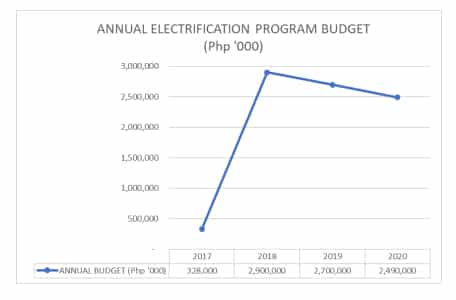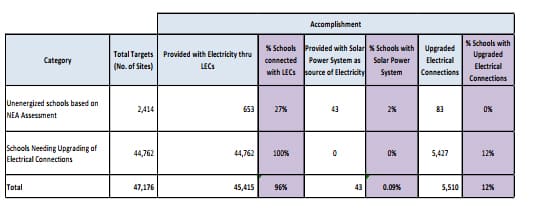Attached herewith is Aide Memoire dated June 05, 2020, from Alain Del B. Pascua, Undersecretary for Administration, DepEd Executive Committee, relative to Completing the First Phase of the Solar and Electrification Program for Schools.
Table of Contents
Completing the First Phase of the Solar and Electrification Program for Schools
The Department of Education (DepEd) remains committed in providing a conducive teaching and learning environment for our learners and teachers. However, the Department recognizes that this cannot be fully implemented in unenergized public schools especially those in geographically isolated and disadvantaged areas. The absence of electrical power automatically limits access to technology, to enhanced instructional methods, and to more engaging teaching-learning activities—factors that affect and compromise students’ academic performance.
In 2015, DepEd embarked on a campaign called “LightEd PH” with the goal of providing schools with electricity through existing local electrical connection within the surrounding community or coverage area, and to provide alternative energy sources such as solar generator sets and solar panels for off-grid schools as a stand-alone and self-sustaining technology systems. Through the assistance of the National Electrification Administration (NEA), they assessed and identified 2,414 schools nationwide that lacked this kind of facilities. However, the funding for this program was only realized in 2017 after DepEd submitted its proposal to include this program in the 2017 budget during the budget deliberations in 2016.
Annual Budget
The pilot implementation of the program was done in 2017 under the Basic Education Facilities Fund (BEFF)-Electrification Project for schools. Thereafter, the need for boosting the implementation of the program was recognized by DBM through the provision of higher annual budget.

In its pilot implementation, the assessment and validation of the original priority schools as determined by NEA was a challenge to DepEd Engineers due to the following:
a. The actual location of the schools are very far from the available tapping points of the Local Electric Cooperatives (LECs);
b. The design and configuration of the Solar Power Supply System for identified schools needed further refinement especially in determining the actual electrical needs of the schools. Likewise, school buildings located in far-flung areas are mostly made of local materials and are not structurally stable for the Solar Power Supply System Design.
This led the Education Facilities Division (EFD) to expand the program not only for the 2,414 unenergized schools but also for those schools that needed upgrading of electrical connections, particularly Senior High Schools with various specializations requiring equipment with large electrical capacity. With the greater electrical demand not matching the existing electrical capacity of the schools, upgrading is necessary to avoid fluctuations and/or fires.
The upgrading of electrical connections of schools was then a part of the priority in this program aside from the two priorities mentioned above. The upgrading of the electrical facilities became part of the budget proposals and projections of requirements for the schools.
Accomplishments and Remaining Requirements
From 2017 to 2020, a total of 779 schools or 32% of the 2,414 unenergized schools were provided with electrical connections: of these, 43 schools were connected through the provision of Solar Power Supply System. In addition, a total of 5,427 other existing energized schools have undergone upgrading of electrical connections as this is necessary given their present electrical requirements.

Breakdown of the total number of schools programmed from 2017-2020 out of the total 2,414 identified unenergized schools.
| CY | Programmed Schools from the 2,414 Unenergized Schools | |||||
|---|---|---|---|---|---|---|
| Connection Thru LEC | Connected thru Solar Panels | Validated to be already Connected but needs Upgrading | ||||
| Total Sites | Project Cost | Total Sites | Project Cost | Total Sites | Project Cost | |
| 2017 | 546 | 187,613,606 | 11 | 19,011,436 | ||
| 2018 | 77 | 101,273,051 | 45 | 64,199,096 | 40 | 46,684,833 |
| 2019 | 8 | 11,286,919 | 12 | 13,452,715 | ||
| 2020 | 22 | 36,156,359 | 2 | 2,973,490 | 20 | 33,182,869 |
| TOTAL | 653 | 336,329,935 | 47 | 67,172,586 | 83 | 112,331,853 |
The said accomplishment has led to a total of 97% of all schools nationwide to be connected with electricity. The remaining 1,635 schools not yet energized is included in the proposal for 2021 but with consideration on alternative sources of energy and with further collaboration with LECs for possible connection with them.
Moreover, the included schools in the Last Mile Schools Program of the Department are 918 of the 2,414 unenergized schools. Of which, 351 schools were already programmed in the Electrification Program and the rest will be included in the finalization of programming under the Last Mile Schools Program.
The upgrading of electrical connections for the remaining schools is still a priority of the program and is included in future budget proposals under the Basis Education Facilities Fund (BEFF). The current changes in the physical conditions of the schools where additional school buildings are being constructed to enhance the curriculum through the use of multimedia and and other ICT equipment makes it imperative to upgrade electrical requirements.
The total estimated cost to cover all the remaining requirements of the schools mentioned above is P61.40 billion as shown in the table below. This requirement will be proposed for incusion in the annual budget of the Department from 2021-2022.
| Category | Balance of Requirements | Total Estimated Budgetary Requirements (Php) |
|---|---|---|
| Unenergized schools based on NEA Assessment | 1,596 | 2,394,000,000 |
| Schools Needing Upgrading of Electrical Connections | 39,335 | 59,002,500,000 |
| Total | 40,931 | 61,396,500,000 |
Remaining Challenges on the Implementation of the Program
Greater Collaboration with the Local Electric Cooperatives thru the National Electrification Administration.
The assistance of the LECs is vital in carrying out the program since in the present implementation setup, the plans and program of works made by the DepEd Engineers are being reviewed by the LECs to ensure compliance with their requirements particularly if schools will be provided with transformers. A Memorandum of Agreement (MOA) is being recommended with NEA as the policy making body providing guidance to the LECs. This will strengthen the partnership with the respective LECs in the assessment, validation, and implementation of the program.
The directions of DepEd’s Electrification program are:
- Attach the nearest schools in the last on-grid electrical posts (2017 objective)
- Provide electricity to off-grid schools thru solar power generation system
- Upgrade electrical system and provide transformers to schools needing more power because of use of equipment like welding machines and a number of computers
- Provide solar panels to all schools
- Repair and upgrade existing electrical systems
Prioritization of Stand-alone Electrification Projects :
First Priority (2020)
- Provide Solar Power to off-grid schools that are not identified as LMS
- Repair and upgrade electrical system, and install transformers in schools with high consumption of energy like SHS with welding courses, and schools with more than 200 computers
Second Priority (2021)
- Solar Panels for schools with newcon before 2010
- Solar Panels for roofs of newcon buildings constructed from 2010- 2020
Solar panel installation includes repair and upgrading of Electrical System
Incorporation of Electrification Projects in BEFF Programs (2021-2023)
- Solar Panel in LMS New Con
- Solar Panels in Classroom New Con
- Repair and Upgrading of Electrical System in 5-year Classroom Repair
Hiring of Additional Electrical Engineers for the Massive Assessment and Validation of School Electrical Requirements
The DepEd currently has a total of 35 Electrical Engineers under Contract of Sendee (COS) partially covering electrical assessment and validation of school needs and installations in 81 provinces nationwide. To ensure timely assessment and validation activities, there is a need to hire 127 additional COS Electrical Engineers to complete the necessary two-engineer-per-province setup. This will require an annual budget of P63.7M to cover compensation.
It is proposed that Congress allocate P61.4 billion and P63.7 million, or a total of P61.4637 billion, to complete the first phase of the solar and electrification program for schools under this administration.
With this amount, all schools will be lighted and energized with the LMS having solar power energy and SHS with transformers and upgraded electrical systems. The next administration can embark on 2023 the second phase of this program which is the completion of solar panel installation and electrical upgrade in all the rest of the schools.
Alain Del B. Pascua
Undersecretary
Thanks for the information, Sir. Anyways, would it be possible to know the list of the unenergized schools?